Wilderness
Wilderness is a natural area affected primarily by the forces of nature with little evidence of man's works -- where man himself is a visitor who does not remain. Many individuals seek out its peace and solitude, yet it has different meanings and values to different people depending on whether they are backpackers, hunters, photographers, or hikers. Get ready to explore the world away from people by visiting one of the seven nationally designated wilderness areas on the Mark Twain.
Although smaller than most Wildernesses in the National Forest System, they are nonetheless wild areas of great natural beauty.
Bell Mountain Wilderness
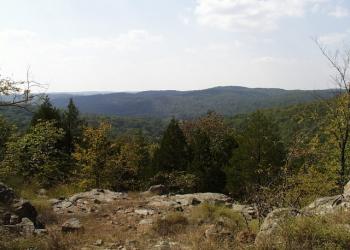
A wonderful place to spend the day hiking! This 9,143 acre wilderness is part of the St. Francois Mountains, one of the oldest landforms in North America.
Devils Backbone Wilderness
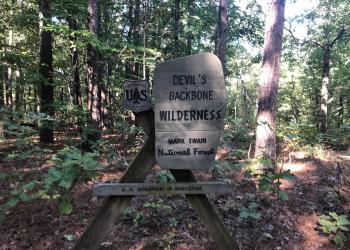
Devils Backbone Wilderness, taking its name from a long narrow ridge known to the early settlers as Devils Backbone, is a unique blend of Missouri Ozark flora and fauna, characterized by rugged topography, springs and the North Fork River.
Hercules-Glades Wilderness Area
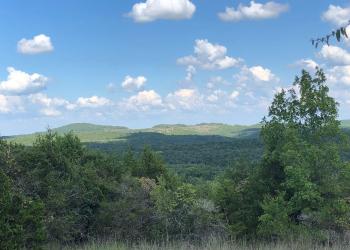
Hercules Glades Wilderness Area is 12,413 acres of the most scenic and unique country in the Midwest. The Wilderness is located 10 miles northeast of Branson, MO.
Irish Wilderness

The 16,277-acre Irish Wilderness is a dense forest of oaks and hickory that was designated in 1984. Here you'll find sinkholes, disappearing streams that reappear downstream, and Whites Creek Cave, (please note that Whites Creek Cave is closed to the public).
Paddy Creek Wilderness
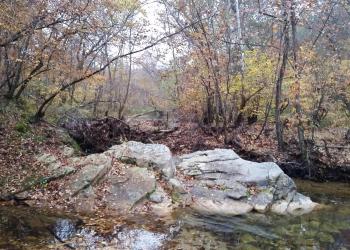
This 7035-acre wilderness is located in northwestern Texas County. In the early 1800’s Sylvester Paddy began the first logging of the area, transporting timber from this area by river to St. Louis. Until the 1930’s the area was homesteaded and grazed as open range. It became federally designated wilderness in 1983.
Piney Creek Wilderness
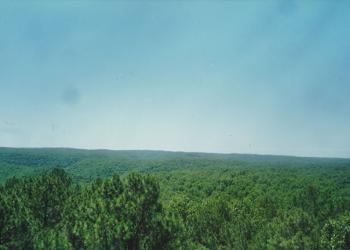
The United States Congress designated the Piney Creek Wilderness in 1980 and it now has a total of 8,178 acres. This wilderness is nestled on the west side of Table Rock Lake.
Rockpile Mountain Wilderness
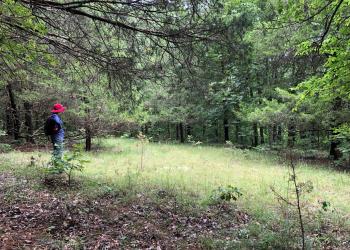
This 4,238 acre Wilderness takes its name from an ancient circle of granite rock, piled by some earlier man on top of the mountain. It is located in Madison County on the Fredericktown Ranger District, southeast of Bell Mountain and southwest of Fredericktown, Missouri.
Visiting the Wilderness
Increasing numbers of Wilderness users may seriously impact the very values they seek. To insure that these values remain intact, please practice good wilderness manners and comply with the regulations listed below.
The wilderness deserves your protection. When you visit, practice "leave no trace" techniques of traveling and camping.
Today, backpackers should leave no sign of their presence so that the next person can enjoy natural scenes and solitude. You must Tread Lightly so nature can endure and replenish.
- There are self-registration stations at each wilderness trailhead entrance shown on the map. Overnight and day use visitors are requested to register.
- Plan your party size, limit size of group to 10 persons or less. This reduces impact on soil and ground cover. Campsites are available on a first-come, first-served basis.
- Be prepared --- have the right equipment and clothing for primitive travel and the season of the year.
- Carry a good map and compass;
- practice safety and carry a first aid kit.
- The universal distress signal is three of anything: shots, shouts, smokes, whistles.
- Tell someone where you are going and when you will get back.
- Pack your own shelter, including needed poles and stakes.
- Protect the solitude; seek out campsites that are out of sight and sound of trails and other camps. When sharing an area keep a low profile and maintain the solitude.
- Avoid overuse of popular areas, and search out the lesser known attractions.
- Dispose of human waste at least 100 feet from campsites, trails and waterways. Dig a shallow hole and cover, nature will biologically decompose.
- Keep the number of campfires low and small in size. Dead fallen trees add to the natural environment and future shortages may cause complete restrictions.
- Fire rings are unnatural signs of man and should be avoided. The use of small gas or chemical cooking stoves is recommended.
- Use care with open campfires - make sure they are dead out and their evidence is scattered before leaving. Visit Smokey Bears website for more information on campfire safety.
- Remember that in many remote areas cell phone coverage is limited or non-existent. If you choose to carry a cell phone for safety or emergencies, be considerate of other visitors.
- When traveling on a trail, stay on the trail. When traveling cross-country use your map and compass. Use of blazes, ribbons, or other trail markers should be avoided; let the next fellow find his own way as you did.
- The Wilderness may be surrounded by private property. Please respect the rights and property of private landowners.
- Do your part to protect the natural conditions found in Wilderness. Always clean weed seeds from clothing, gear and animals before entering the area. Report any non-native invasive species that you see, including feral hogs.
- Leave your camp cleaner than you found it. Pack out what you pack in. Animals generally dig up what you bury, so don't.
Regulations
To help keep human impacts from damaging wilderness some activities are not allowed in congressionally designated wilderness areas:
- Possessing or leaving refuse, debris, or litter in an exposed or unsanitary condition.
- Placing in or near a stream, lake, or other water any substance which does or may pollute a stream, lake, or other water;
- Leaving a fire without completely extinguishing it;
- Cutting or defacing live or dead standing trees or other vegetation;
- Possessing or using motorized equipment or mechanized transport;
- Landing of aircraft, or dropping or picking up any material, supplies or persons by means of aircraft including helicopters;
- The building of "structures" such as rock fire rings, tables, lean-tos and the like;
- Discharging a firearm or any other implement capable of taking human life or causing injury, in or within 150 yards of an occupied area, or In any manner or place whereby any person or property is exposed to Injury or damage as a result of such discharge;
- Firing any tracer bullet or incendiary ammunition.
- Missouri Department of Conservation hunting and fishing regulations and license requirements apply.
- Camping within 100 feet of an established trail, stream, body of water, cave, rock, shelter, other occupied campsites or other restricted camping areas.
- Building, maintaining, attending or using a fire, campfire, or stove fire within 100 feet of an established trail.
- Using a trail, campsite or other land area of the wilderness by more than 10 people at any one time or travelling as a group by more than 10 people in any area of the wilderness.
- Possessing or using a bicycle, wagon, cart, or other vehicle.
- Riding, hitching, tethering, or hobbling a horse or other saddle or pack animal in violation of posted instructions. Hitching or tethering saddle or pack animals directly to live trees is prohibited.
- Riding, hitching, tethering, or hobbling a horse or other saddle or pack animal in violation of posted instructions. Picketing horses or mules within 100 feet of water or trail is prohibited.
- Storing equipment, personal property, or supplies.
- Disposing of debris, garbage, or other waste.



